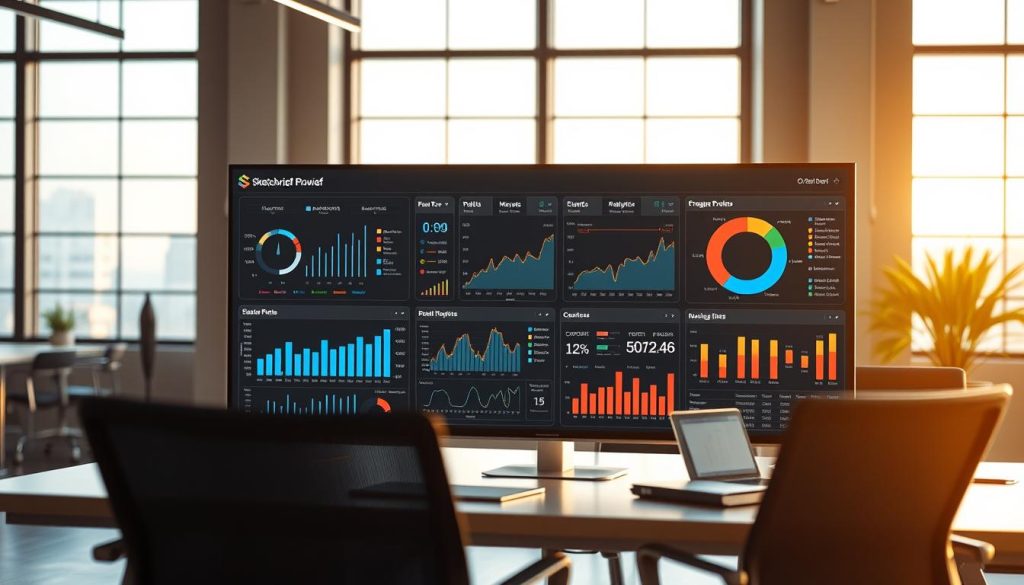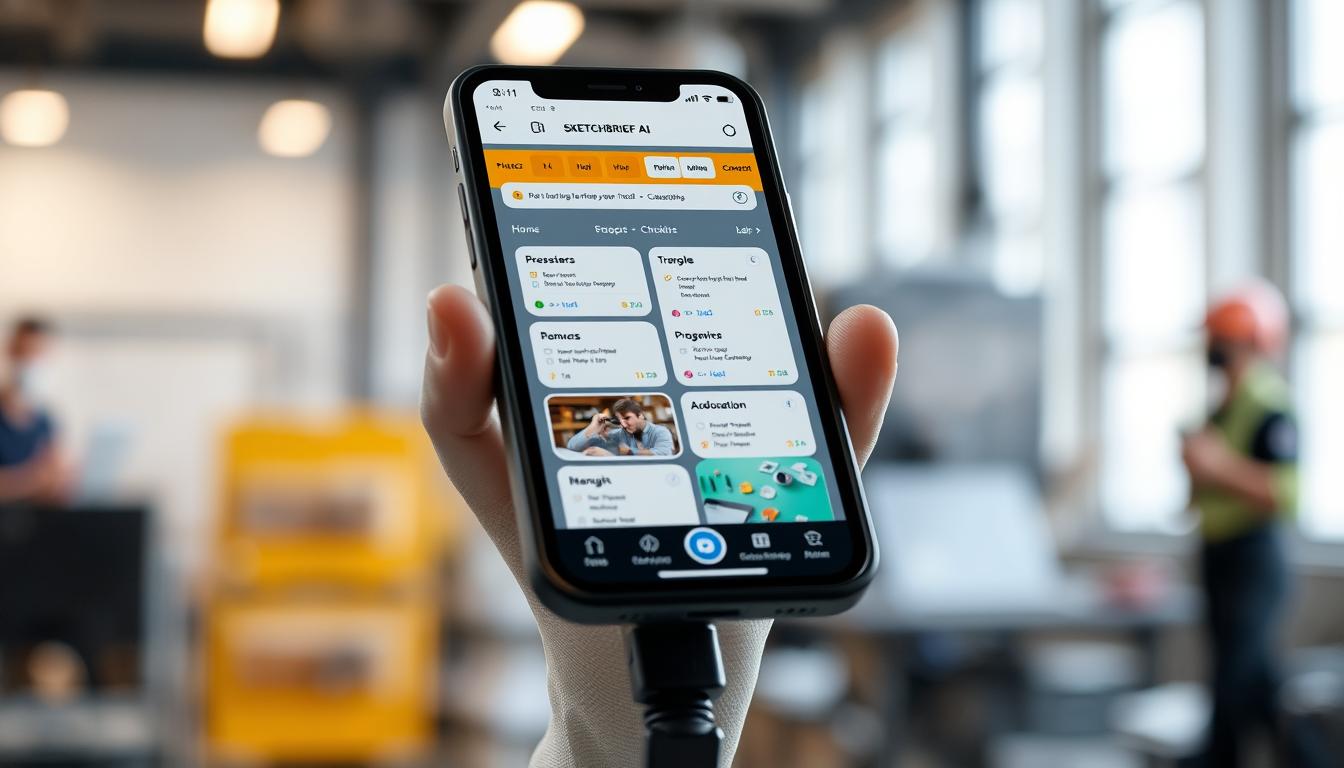Question: Could a single tool really cut paperwork, speed approvals, and keep your crew moving without extra phone calls?
We answer that by reviewing the top solutions that connect crews and the office in one place. A strong field work documentation app and a reliable mobile app boost accuracy, shorten job cycles, and deliver clearer reports.
We focus on ease of use, mobile-first performance, integrations with CRM and accounting, and security controls. You’ll see which platforms offer photo capture, signatures, checklists, invoicing, quoting, and fleet tracking—features that drive better reporting and visibility.
Our goal is practical: help you choose one platform that centralizes records so your team spends less time searching and more time executing the right way. We highlight pricing models and how solutions scale with team size and project complexity.
Key Takeaways
- Choose a mobile-first platform that works offline and syncs fast.
- Prioritize photo capture, signatures, and checklists for cleaner reports.
- Integrations with CRM and accounting reduce duplicate entry.
- Look for strong access controls and secure data handling.
- Compare pricing models—free trials, per-user, and custom quotes.
Why mobile field documentation matters right now in the United States
Timely on-site records drive faster decisions and better customer experiences across U.S. service teams.
Every minute counts. Moving from paper and patchwork tools to a connected mobile app removes guesswork during HVAC installs, electrical repairs, or plumbing emergencies.
Techs capture photos, notes, and issues once on-site. Those updates sync to the office and cut repeat calls and delays.
User intent: faster reporting, fewer delays, better visibility
Customers expect same‑day service and clear status updates. A mobile solution enables faster reporting that customers notice.
Dispatch can reroute the right field tech based on skill and proximity. That lowers drive time, idle hours, and schedule disruptions.
From paper to platform: closing the field-office gap
Supervisors gain instant visibility into open jobs, time on site, and completions. This makes resource management and compliance easier.
- Offline capability keeps crews logging jobs where signal is weak.
- Standardized checklists improve consistency across teams and service categories.
- Accurate reporting at the point of work simplifies audits and warranty claims.
What a field work documentation app is—and how it supports service management
A good on-site reporting system turns scattered notes and photos into structured reports your office can use the same day. We use software that captures observations, tags locations, and templates progress so teams spend less time fixing paperwork and more time on projects.
Definitions: field reporting software vs. field service apps
Field reporting software focuses on documentation workflows—notes, photos, annotations, and PDF reports that preserve site details and support audits.
Field service platforms add dispatch, quoting, invoicing, and payments for end‑to‑end service management. Choose the latter when you need job scheduling and billing in one system.
Core workflows covered: notes, photos, tasks, reports, and access control
Core workflows include standardized notes, photo evidence, checklist-driven tasks, and templated reports with role-based access control. That combination reduces errors and speeds approvals.
- On-site data feeds the system instantly for real-time decisions.
- Offline-first capture and location tagging protect progress in low-signal areas.
- Assign responsible parties, due dates, and correction status to keep projects aligned.
- Templated reports and controlled access help with compliance and multi-site consistency.
In short: a compact platform ties site information to office processes so managers see accurate progress and details without waiting on email.
Must‑have features for accurate reporting, tracking, and compliance
Modern service management depends on practical features that reduce steps and errors. We look for tools that keep teams informed, speed billing, and preserve an audit trail without extra admin time.

Real‑time scheduling, dispatch, and mobile‑first access
Real‑time scheduling matches the nearest skilled tech and cuts time between jobs. Mobile app access that works online and offline keeps updates flowing even in low signal areas.
Checklists, digital forms, and document management
Standardized checklists and digital forms enforce consistency. Required notes and attached files create a clear audit trail for compliance and faster approvals.
Photos, annotations, and location tagging
Photos with annotations clarify issues and reduce rework. Precise location tagging and timestamps provide indisputable evidence of progress and corrections.
CRM / job history, integrations, and data control
CRM access gives techs context—prior visits, equipment quirks, and customer preferences—so first visits are more effective.
Integrations with accounting and document systems prevent duplicate entries and keep data consistent across your platform. Role‑based control restricts sensitive pricing and customer data to the right people.
Reporting dashboards, alerts, and PDF generation
Dashboards and alerts turn raw reporting into action. They surface bottlenecks, slow approvals, and at‑risk deadlines early.
One‑click PDF generation compiles photos, timestamps, assignees, and notes into shareable reports your office and clients can approve quickly.
| Feature | Benefit | Typical Use | Impact on Business |
|---|---|---|---|
| Real‑time dispatch | Faster assignments | Emergency reroutes, ETAs | Less idle time, lower travel costs |
| Digital forms & checklists | Consistent inspections | Compliance, audits | Fewer errors, faster approvals |
| Photos + location tags | Clear evidence | Repairs, claims | Reduced rework, better client trust |
| Integrations & control | Single source of truth | Accounting, CRM sync | Less duplicate entry, secure data |
Types of platforms: office‑based, web‑based, and mobile‑native apps
Platform choice hinges on whether you need heavy back‑office control or fast on‑site capture.
Office‑based platforms fit centralized businesses with big admin teams. They offer strong control, deep reporting, and tight integrations with accounting and scheduling.
Web‑based software runs in any browser. It gives broad access and instant updates for dispersed teams. That makes it ideal when visibility and consistent reports matter across sites.
Choosing by team size, trades, and operations complexity
Mobile‑native apps deliver the fastest field experience. They prioritize offline support, camera‑first features for photos and notes, and streamlined checklists for quick task completion.
- Small residential services: favor simple tools that reduce training and speed visits.
- Multi‑trade commercial ops: need deeper management, custom reports, and robust tracking.
- Balanced option: mobile‑friendly web platforms give admin depth without overloading users in the field.
Tip: require role‑based control so users see only what they need. Confirm core features—document storage, checklists, task assignments—work on phones and tablets your team already uses.
Finally, evaluate total cost of ownership: include training, data migration, integrations, and ongoing support when you compare solutions.
Top 7 field documentation apps for mobile workers
Here are seven proven platforms that streamline on-site tracking, invoicing, and project visibility. Each entry focuses on mobility, reporting, and practical features you can evaluate quickly.
BuildOps — best for commercial contractors needing one platform and visibility
Why it stands out: mobile access to job details and checklists, live drag‑and‑drop scheduling, and centralized customer and equipment records for multi‑project visibility.
Housecall Pro — best for residential service teams prioritizing speed
Simple setup, calendar booking, customer portal, text updates, and real‑time tech tracking. Tiered pricing suits growing residential services.
Jobber — best for mixed job types with balanced features
Visual scheduling, route tracking, quoting and invoicing, plus client records—good when you need breadth without complexity.
FieldEdge — best for growing teams moving off spreadsheets
Dispatch, CRM with asset visibility, live tracking, and integrations that replace manual spreadsheets and speed office approvals.
ServiceTitan — best mobile‑first experience with offline access
Designed for the mobile user: offline forms, signatures, payments, GPS, and messaging to cut follow‑up time.
Service Fusion — best for multi‑trade coordination and service zones
Flat monthly pricing, no per‑user fees, skill tagging, service zones, and role‑based access for complex operations.
Deltek ArchiSnapper — best for field reporting software focused on site observations
Photos, annotations, location tags, checklists, and one‑click PDF reports. Built for firms that value thorough site notes and faster reporting.
- Check before you buy: integrations, access controls, and pricing terms that match your office processes and reporting needs.
How these apps compare on features, workflows, and reporting
We map platform strengths against common on‑site needs—reporting speed, GPS tracking, and role‑based access—to help you pick the best fit.
Feature depth varies: BuildOps and ServiceTitan offer broad management and multi‑metric reporting. ArchiSnapper focuses on high‑quality observation capture and PDF reports.
Mobile offline access is strongest in ServiceTitan and ArchiSnapper. Make sure your chosen app lets users access tasks and information without connectivity.
Tracking and visibility: Some systems emphasize live vehicle and tech status. Others prioritize project progress, photos, and issue capture for audits.
- Access control: Compare role permissions for pricing and sensitive customer data.
- Workflows: Dispatch, quoting, invoicing, and ticket updates should sync instantly to avoid duplicate data entry.
- Integrations: CRM and accounting links reduce manual work and prevent issues later.
| Strength | Best for | Notes |
|---|---|---|
| Management & reporting | BuildOps, ServiceTitan | Multi‑metric dashboards, deep controls |
| Observation & reports | ArchiSnapper | Photo‑first reports, one‑click PDFs |
| Customer communications | Housecall Pro | Online booking and updates |
Final thought: decide if one platform that covers everything suits your business, or if a specialized app will better solve specific documentation and reporting needs.

Pricing and plans: what to expect from field reporting software
Pricing options range from free starter plans to enterprise quotes that include implementation and security. You can test free tiers to confirm core features before buying seats. Many vendors offer mobile access, templates, dashboards, and basic document management at entry levels.
Free and entry tiers: good for small teams. Expect checklists, templates, mobile access, and simple dashboards.
Mid tiers: add integrations, role-based management, richer reports, and more storage for growing teams.
Premium and custom: include implementation help, advanced security, and enterprise integrations that streamline office operations and data flows.
| Vendor | Example pricing | Typical inclusions |
|---|---|---|
| SafetyCulture | $24/user/month (annual) | Checklists, templates, mobile access, basic reports |
| Fieldwire | $39/user/month (annual) | Plan sharing, mobile forms, document storage |
| Autodesk Build / Buildertrend | $200/user/month · $199/month flat | Project controls, advanced reporting, admin tools |
Note: Bridgit Bench, Rhumbix, and FieldPulse often require custom quotes. Factor total cost of ownership: training, data migration, and admin time can exceed headline pricing if you don’t plan for them.
Benefits you can measure: speed, accuracy, and operational visibility
Better visibility and faster decisions come from connecting on-site updates to office systems in real time. When teams log notes, photos, and follow-ups in a single platform, you cut repeat calls and keep jobs moving.
Faster scheduling and fewer missed handoffs
- Real-time scheduling reassigns nearby techs to reduce drive time and idle time.
- Automatic updates to the field office reduce missed handoffs and limit delays between shifts or teams.
Less driving, smarter routes, and better time tracking
- Route optimization and GPS tracking lower fuel costs and shorten travel time across large territories.
- Accurate time-on-site logs show true labor hours for better billing and payroll accuracy.
Performance reporting that highlights bottlenecks
- Reporting on response times and time-on-site reveals recurring delays so managers can rebalance schedules.
- Centralized visibility flags stalled jobs, unblocks approvals, and keeps the ticket lifecycle in flow.
“Accurate documentation and consistent updates reduce repeat visits and improve customer trust.”
Bottom line: measured gains include lower travel costs, fewer delays, clearer status updates for customers, and actionable reporting that improves operations and business margins over time.
Evaluation checklist to choose the right field work documentation app
We recommend a short, practical checklist so you can judge candidates against real on‑site needs. Start by matching usability and offline reliability to the daily routines of your crews.
Usability in the field
Can users complete tasks without extra calls?
Verify that a user can capture photos, add notes, and submit reports in one flow. Simple screens and clear prompts speed task completion.
Offline, syncing, and data handling
Does the system store and sync information securely?
Confirm offline inspections save data locally and sync automatically. Check encryption, device lockout, and role‑based access for control.
Integrations and workflow testing
Will CRM, accounting, and scheduling link cleanly?
Test end‑to‑end workflows—from dispatch to closeout. Verify timestamps, location tagging, PDF generation, and audit logs for tracking and compliance.
- Prioritize features you will use—avoid buying unused extras.
- Include users in a pilot to surface issues and information gaps.
Implementation playbook: from pilot to full rollout without disruption
Start small with a pilot team and a limited service area to validate workflows and quantify gains. This reduces risk and shows early wins to the rest of your team.
Define roles and control settings early. Set permissions so the right people see the right information in the office and on the move.
Build a short training plan with hands-on sessions. Focus on three core tasks: schedule, document, report. Repeat until the flow feels natural for every user.
Establish a cadence for updates, feedback, and quick wins. A clear schedule for tweaks keeps momentum and limits downtime.
Map integrations and migrate historical information carefully so reports and customer records are accurate from day one.
- Measure time-on-site, first-visit resolution, and report completion.
- Communicate progress to both the field and office teams to speed adoption.
- Scale in phases, adding crews and services as stability is proven.
| Phase | Goal | Key metric |
|---|---|---|
| Pilot | Validate process and training | Time savings per job |
| Expand | Roll out to more teams | First-visit resolution rate |
| Optimize | Refine integrations and control | Report completion rate |
Conclusion
Picking the right platform starts with mapping how your crews capture progress and how the office uses reports.
Focus on core features that drive outcomes—offline access, checklists, photos, and templated reporting. Match the solution to your business needs: commercial coordination, site observation, or mixed services.
Keep training simple and role‑based so teams use tools the fastest way to log notes, status, and details. Verify integrations and real‑time visibility so managers act on live data instead of chasing updates.
Balance pricing with total value—support, rollout effort, and fit matter. With a clear plan you gain reliable records, faster approvals, and measurable gains in time, consistency, and customer confidence across projects.

Leave a Reply